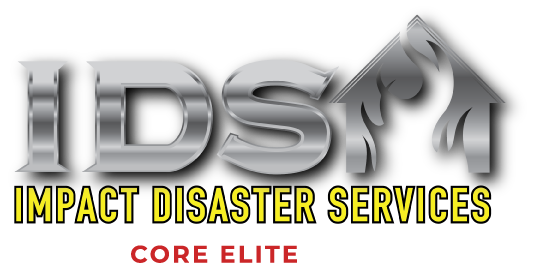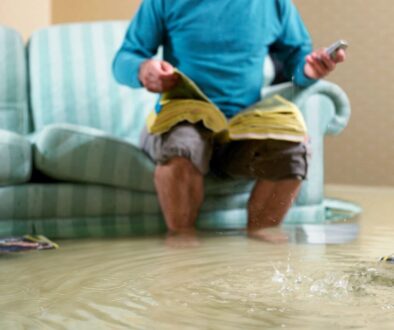Steps to Take After Discovering Water Damage
Discovering water damage in your home can be worrying. Water can cause a lot of trouble to houses, but knowing what steps to take can help a lot. If you live in an area served by Impact Disaster Services, understanding these steps is especially helpful. Let’s look at what you should do if you find water damage in your home.
Signs of Water Damage
First, it’s important to know how to spot water damage. Sometimes, it’s not as obvious as a big puddle of water. Here are some signs to look out for:
- Wet Spots: Look for dampness on your walls, floors, or ceiling. These spots might be a different color or feel soggy.
- Strange Smells: If there’s a musty or moldy smell, that can mean there’s water damage somewhere.
- Peeling Paint or Wallpaper: Water can make paint or wallpaper start to peel off or bubble up.
- Mold or Mildew: These are little black, green, or white spots that can grow in damp places.
- Sounds of Dripping Water: Listen for any dripping or trickling sounds, even if you can’t see the water.
By looking for these signs, you can catch water damage early, which is really important.
Electrical and Structural Concerns
When you’re dealing with water damage, it’s crucial to think about electrical and structural safety. Water can be a dangerous partner to electricity, and it can also weaken parts of your home. If the water damage is near any electrical outlets, appliances, or your home’s wiring, you need to be very careful.
First, consider turning off the power to the affected area, but only if you can do so safely. This reduces the risk of electrical accidents. It’s really important not to touch any electrical items if they’re wet, or if you’re standing in water – this can be very dangerous.
Beyond electricity, it’s also essential to keep an eye on the structure of your house. Water can make floors and walls weaker, so be mindful of where you step and avoid areas that look damaged. One particular area to watch out for is your ceiling. If it’s wet, it might be sagging or could potentially collapse. It’s best to avoid rooms where the ceiling doesn’t look safe.
Remember, when tackling water damage, your safety is the most important thing, especially around electricity and weakened structures in your home.
Documenting the Damage
After making sure it’s safe to do so, the next step in dealing with water damage is to document everything. This is important, especially if you’re going to talk to your insurance company about fixing your home. Here’s what you can do:
Take a lot of pictures and videos of the damage. Make sure to capture all the areas affected by water, like walls, floors, furniture, and electronics. These photos and videos provide a clear record of all the damage for your insurance claim.
Write down a list of everything that’s damaged. Include things like books, clothes, and any other items that got wet or ruined. This list helps when you talk to the insurance company because it shows exactly what needs to be replaced or repaired.
Remember to keep all your documents and records safe. You might need them when working with your insurance company and repair services.
Stopping the Source
Once you’ve documented everything, the next step is to stop more water from coming in. This is really important because it helps prevent further damage. Here’s how you can do it:
Find out where the water is coming from. Is it a burst pipe, a leaky roof, or something else? Once you know the source, you can start fixing it.
If it’s a plumbing issue, like a broken pipe, you might need to turn off your home’s main water supply. This stops the water flow and gives you time to figure out what to do next.
If the water is coming in from outside, like through a broken window or a hole in the roof, try to cover it up with a tarp or some plastic sheeting. This is a temporary fix, but it can help keep more water from getting inside.
Remember, if the problem seems too big or you’re not sure how to fix it, it’s okay to ask for help from a professional.
Beginning the Cleanup
After you’ve documented the damage and stopped more water from coming in, it’s time to start the cleanup process. This step is crucial in restoring your home and preventing further issues like mold growth. Here’s what you should focus on:
Start by removing the water. You can use a wet-dry vacuum, available at most hardware stores, or towels and mops if the amount of water is manageable. The faster you get the water out, the less chance there is for additional damage.
Dry out the affected area next. Fans and dehumidifiers work great for this. Good air circulation is key in drying out wet areas and reducing moisture levels. Remember, the goal is to dry things as quickly as possible to prevent mold and mildew.
Clean and disinfect all wet areas. This includes floors, walls, and any household items that got wet. Use a good disinfectant to kill any bacteria and mold spores. This step is essential for keeping your home safe and healthy.
If you have items that are too damaged to save, it’s time to let them go. This might include waterlogged books, ruined electronics, or soaked furniture. It’s tough to throw things out, but sometimes it’s necessary for your home’s safety and cleanliness.
Returning Your Home to Pre-Damage Conditions
The final step in handling water damage is to restore your home to how it was before the trouble started. This can be a big task, but with the right approach and help, it’s definitely achievable. Here’s what’s involved in this process:
Repair and Rebuild: Depending on the extent of the damage, some parts of your home may need repairs or even complete rebuilding. This could involve fixing walls, replacing flooring, or repainting rooms. Professional restoration services like Impact Disaster Services have the expertise to handle these repairs and ensure that everything is done correctly and safely.
Restoration of Personal Items: Water damage can affect not just your house but also your belongings. Professional services can help restore items like furniture, curtains, and even important documents. They use special techniques to bring your things back to life, saving those precious items that are important to you and your family.
Mold Prevention and Remediation: Even after everything is dry and clean, there’s still a risk of mold growth. Professionals can treat your home to prevent mold from growing. And if mold is already present, they can safely remove it. This step is crucial for maintaining a healthy living environment.
Final Inspection and Safety Check: After all repairs and cleaning, a final inspection is important to make sure everything is safe and back to normal. This usually involves checking the structural integrity of the home, ensuring electrical systems are safe, and confirming that there are no lingering moisture or mold issues.
By following these steps and working with a reliable restoration company like Impact Disaster Services, you can bring your home back to its original condition, or maybe even better! They understand the challenges of water damage and offer expert solutions to help Pennsylvania residents recover from these incidents.
When to Call the Experts
Sometimes, the damage from water can be too much to handle on your own. Knowing when to call in professional help is important. Here’s when you should consider it:
- If there’s a lot of water, or if it’s spread over a large area, getting help from a water damage restoration company like Impact Disaster Services can be a smart move. They have the right tools and experience to handle big jobs.
- If you find mold, it’s a sign to call the pros. Mold can be tricky to deal with and can cause health problems, so it’s better to let experienced professionals take care of it.
- If there’s damage to the structure of your home, like weakened walls or floors, this is definitely a job for experts. They can ensure everything is repaired safely and correctly.
Remember, calling in professionals isn’t just about fixing things. It’s about making sure your home is safe, healthy, and comfortable again.


